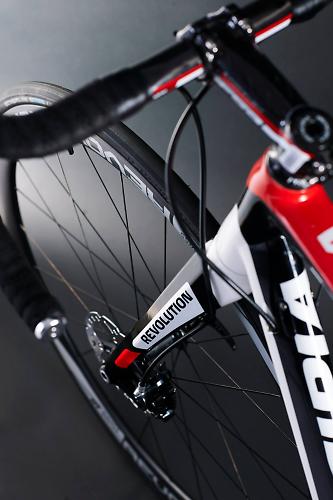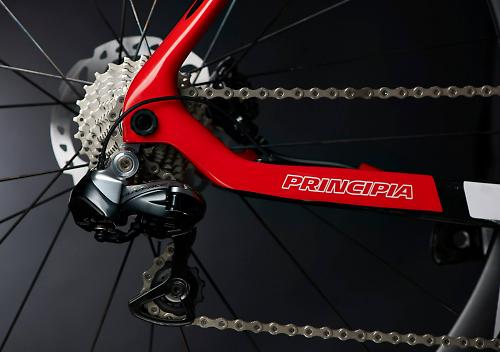- News
- Reviews
- Bikes
- Components
- Bar tape & grips
- Bottom brackets
- Brake & gear cables
- Brake & STI levers
- Brake pads & spares
- Brakes
- Cassettes & freewheels
- Chains
- Chainsets & chainrings
- Derailleurs - front
- Derailleurs - rear
- Forks
- Gear levers & shifters
- Groupsets
- Handlebars & extensions
- Headsets
- Hubs
- Inner tubes
- Pedals
- Quick releases & skewers
- Saddles
- Seatposts
- Stems
- Wheels
- Tyres
- Tubeless valves
- Accessories
- Accessories - misc
- Computer mounts
- Bags
- Bar ends
- Bike bags & cases
- Bottle cages
- Bottles
- Cameras
- Car racks
- Child seats
- Computers
- Glasses
- GPS units
- Helmets
- Lights - front
- Lights - rear
- Lights - sets
- Locks
- Mirrors
- Mudguards
- Racks
- Pumps & CO2 inflators
- Puncture kits
- Reflectives
- Smart watches
- Stands and racks
- Trailers
- Clothing
- Health, fitness and nutrition
- Tools and workshop
- Miscellaneous
- Buyers Guides
- Features
- Forum
- Recommends
- Podcast
TECH NEWS
Principia's new Revolution with disc brakes, Di2 and bolt-thru axles
Danish brand Principia have joined the disc brake movement with the release of their new Principia Revolution, a bike fitted with Shimano’s new hydraulic disc brakes, a Di2 groupset and 15mm bolt-thru axles in place of regular 9mm quick-release axles.

We don’t have all the details on this new bike just yet (we're working on it), so in the meantime we’ll have to indulge in a spot of light speculation. The frame and fork are clearly made from carbon fibre and it’s been designed from the outset around disc brakes. The most interesting aspect is the use of bolt-thru axles front and rear, 15mm at the front and a 142x12 out back.
142x12 is a rear axle standard that has been readily adopted on mountain bikes in recent years, and comprises an axle with a 12mm diameter with 142mm rear hub spacing. It's a system designed to be as quick and easy to use as a regular quick release, but with the extra security, strength and stiffness offered by the thru-axle design. Why 12mm? Because that's the largest size that will fit through a cassette and lockring without a complete redesign.
The regular quick release hasn't really changed since Tullio Campagnolo first stumbled across the idea in 1927, at the side of the road during a race, when he was struggling with the wing nuts that were standard on road bikes in the early part of the 20th Century.

This is the first time we’ve seen a road bike with bolt-thru axles. Giant recently released their TCX cyclocross bikes with a bolt-thru fork and regular QR rear axle, but as for road bikes we’re struggling to recall any others. Even the Colnago C59 Disc, one of the first disc-equipped road bikes, only had regular quick release axles. We really expect to see a lot more thru-axle use on the next generation of road bikes designed with Shimano and SRAM’s disc brakes in mind, just as has happened over in the mountain bike world.

Principia are using Shimano's recently released hydro disc brake. The rear disc brake uses the post mount standard and is placed inside the rear triangle. The hoses are routed externally, with the front host passing down the back of the fork. The wiring for the Di2 groupset is routed internally. We can presume the carbon fibre laup has been developed specifically, with extra carbon in the high stress areas near the disc brakes, and weight saved in the seatstays which no longer need to support caliper brakes.
A lot of people believe disc brakes will take over in road cycling in the next 10 years, including TRP and SRAM.
Rotor size with the Shimano disc brakes appears to be 160mm at the front and a smaller 140mm at the back. Principia have incorporated the new Shimano Di2 seatpost battery to hide it away, keeping the lines of the frame clean. Componentry includes the new FSA K-Force Light Compact BB386EVO chainset that we told you about the other week.
We'll have more details on this bike, including pricing and availability, soon.
David worked on the road.cc tech team from 2012-2020. Previously he was editor of Bikemagic.com and before that staff writer at RCUK. He's a seasoned cyclist of all disciplines, from road to mountain biking, touring to cyclo-cross, he only wishes he had time to ride them all. He's mildly competitive, though he'll never admit it, and is a frequent road racer but is too lazy to do really well. He currently resides in the Cotswolds, and you can now find him over on his own YouTube channel David Arthur - Just Ride Bikes.
Latest Comments
- Pub bike 59 min 59 sec ago
He is up against the global trading system, which has obviously been in the news a lot lately. Framebuilders in other countries can undercut him,...
- Car Delenda Est 1 hour 19 min ago
You've just confused Israel with Judaism and Palestine with Hamas, do better Rendel
- David9694 2 hours 32 min ago
Stouport residents bemoan huge traffic queues through town...
- lonpfrb 9 hours 58 min ago
That argument is ignorance of the widespread height and width restrictions to be found on the many minor roads that were originally created for...
- rookybiker 13 hours 26 min ago
The trailer seems to connect to both ends of the rear axle. Can it do tight corners without dragging the tyre sideways?
- froze 13 hours 30 min ago
Motorists have always been unkind to cyclists, but distracted driving is adding to the problem....
- Destroyer666 14 hours 23 min ago
Have you owned Bont shoes? In my experience even the widest Lake shoes have had a bizarre form of narrowing way too much in the toe area. But the...
- froze 14 hours 50 min ago
Not sure if this is possible, but this news letter goes out all over the world, and some places like Decathlon does not send stuff to America, in...
- Hirsute 15 hours 35 min ago
I'm confused as to why you'd need bib shorts indoors.




Add new comment
11 comments
stumbled? I think you mean invented David! I agree,15mm front axle is unecessary,a 12mm as used on the rear would be the obvious choice in trying to keep things standard.
There is no reason why the front cable could not be routed internally in a fork. they evem could use the bmx style through the centre of the steerer tube. would look real neat and tidy!
Re: John Stevenson
I didn't mean to cause any offence. I just believe that it's too easy to worry about it too much.
I'm familiar with the whole QR story and I understand the mechanics behind it but the probability of a properly used QR skewers failing is no higher than breaking any random part of your bike or being hit by a car.
Both documented and anecdotal cases are extremely rare and millions of riders are still trashing their mountain bikes with "old fashioned" skewers and 185-203mm rotors on technical trails everyday without a single problem and with wheels sitting exactly in the same place.
15mm axles won't save any lives and make anyone faster. Like most of marketing driven standards they are going to make fewer parts that you already have interchangeable.
'Tullio, what are you doing messing around with those wing nuts? Why change something that isn't broken?'..
You don't need 15mm bolt-thru axles on a road bike.
Another pointless standard in the making.
Whoever believes that QR skewers are not secure enough to withstand (disc) braking forces is paranoid.
€7k that's about £6k! I'll never get that past her in doors!
that's about £6k! I'll never get that past her in doors!
yep, is a no-brainer from a safety perspective to use through-axles, particularly on the front where the braking forces drag the axle downward toward the exit of conventional dropouts.
Bolt through axles offer security against wheels being forced out of fork ends/dropouts by disc calipers.
Bolt-through axles are necessary on MTBs to impart rigidity on an otherwise flexy structures like suspension forks. Road bike frames don't experience the same levels of stress, so finding it hard to understand the benefit except that it'll make wheels changes a bit more of a faff. Like BB30, another dead-end of bike-evolution IMO.
Shame the hydraulic lines are not internal, I accept that's pretty hard to do on the fork but it would really clean up the lines, after mountain biking for years I can't wait to get discs on the road.
according to another site, 6.8k and E7k
That's very nice and, to my mind, has some pretty sensible spec choices (including the BB386EVO). I wonder how much it weighs, and how much it costs...